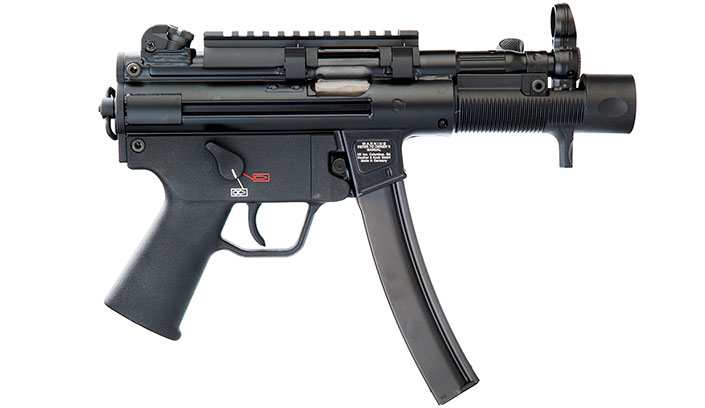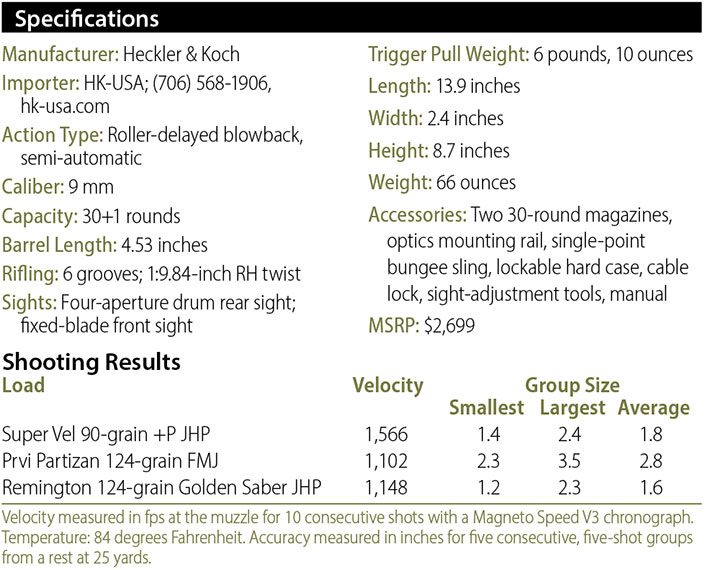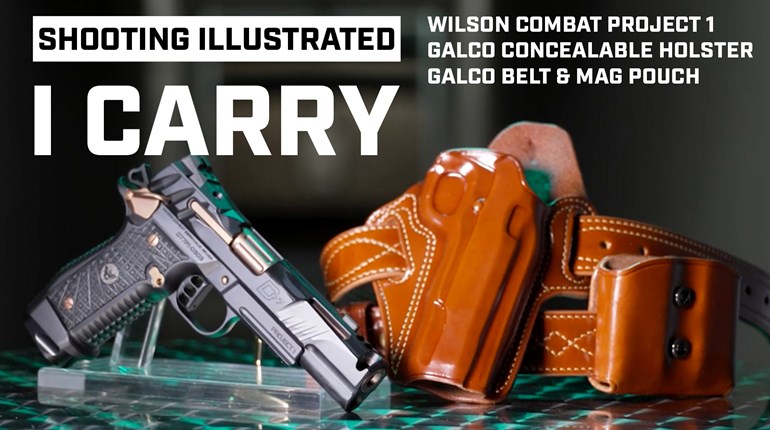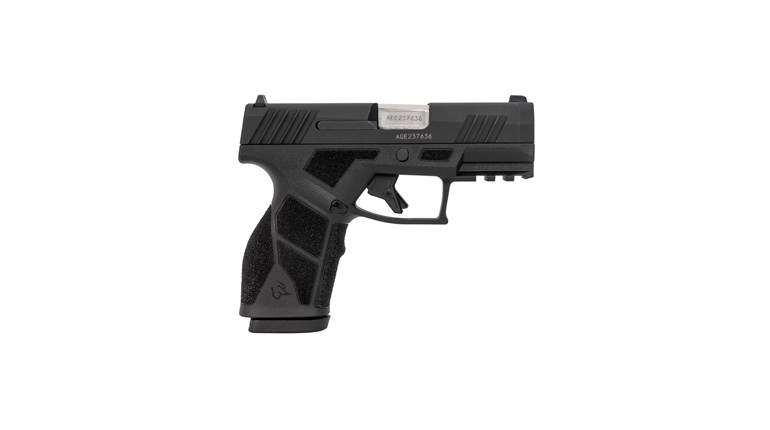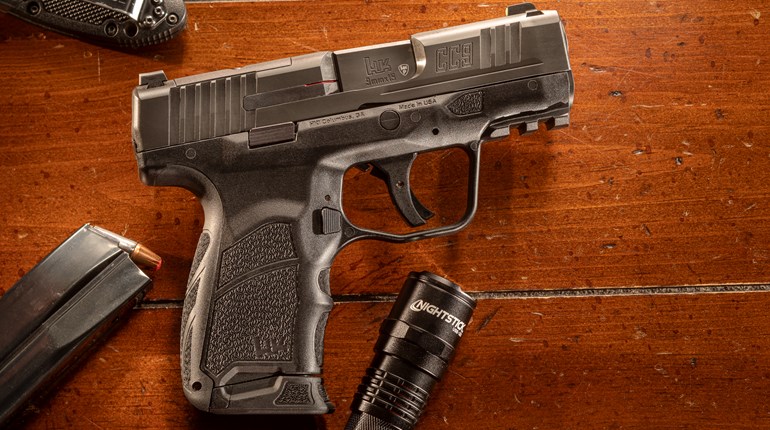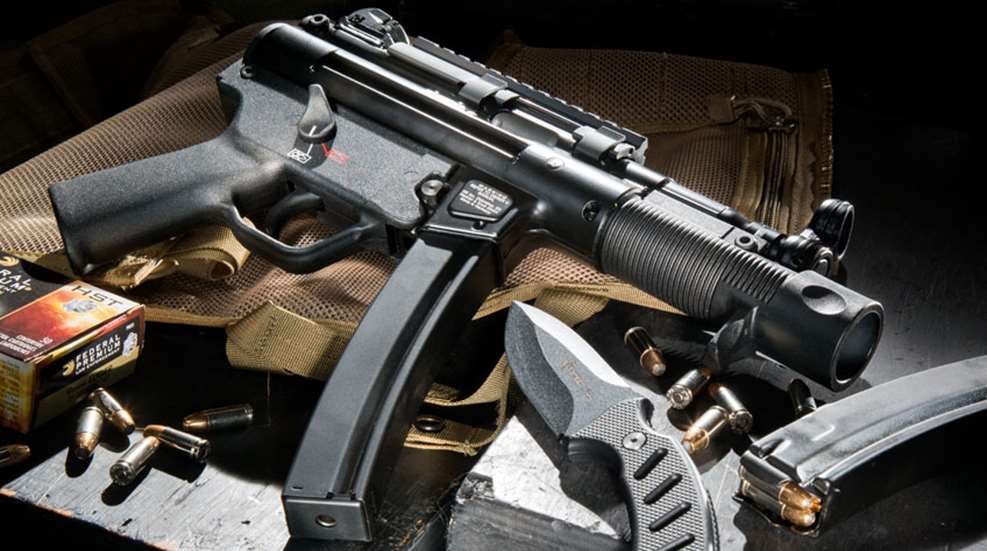
It is mid-2003 and I am in the middle of a war zone. We are running full-tilt, midway through our fourth post-Sept. 11 combat tour. To date I have faithfully lugged around some form of semi-auto sniper rifle, regardless of whether I needed to shoot 1,000 meters away or across a room. But, things are different on this night. The mission calls for more stealth than is normally required (or possible) by a large body of assault troops in a fast-moving and hard-hitting environment. Yet, our commander is adamant: The kill-or-capture operation will be silent—period. This poses a problem, as the centerfire rifle suppressors and caliber choices available at the time are far from effective in managing sound reduction. In fact, when we use our issued rifle suppressors, it is purely for their ability to tame muzzle flash at night.
The stealth requirement whittles my firearm choices down to four candidates: A 7.62 NATO semi-auto with a nearly foot-long suppressor, a 5.56 NATO carbine that is just as noisy suppressed as it is unsuppressed, a Heckler & Koch (H&K) MP5-SD submachine gun and a suppressed pistol firing subsonic FMJ ammo. My instinct is to choose the firearm that covers the greatest number of contingencies in this dynamic environment, but the mandate for maximum sound reduction instead compels me to choose the 9 mm-chambered MP5-SD. I know any ammo I fire through the ported and suppressed barrel will be subsonic—and therefore extremely quiet—and I know from long years of experience with the platform that, if pressed, I can at least fight out to modest distances with the submachine gun. Its accuracy and reliability are not even part of the conscious decision-making process. I know it will always shoot and shoot well.

Things went unusually smoothly on this particular mission. The first inkling our enemies had that we were coming was when they woke up in bed, squinting through startled eyes into American gun lights and muzzles. I never carried an H&K MP5 variant during later tours, but I was glad to have one in my tool bag on that night. It was not my first choice for the environment, but it was right for the mission.
Submachine guns (SMGs) came of age during a time when small, rifle-caliber arms were neither practical nor efficient to manufacture. SMGs provided military and police forces with a sometimes inexpensive ability to carry compact, high-capacity arms with controllable full-auto or selective-fire capabilities. Even though they no longer hold favor on the modern battlefield—shorter, rifle-caliber guns have mostly taken their place—sub guns still find favor in specialized roles and have given birth to a number of civilian-legal offspring.
When Heckler & Koch formally revealed its new SP5K pistol to U.S. consumers at the 2016 NRA convention, gunwriters, bloggers and H&K-fans took notice. Such interest may seem odd given the heavy presence of pistol-size, semi-auto carbine and submachine-gun derivatives on the market today. But if you consider the pistol’s MP5 lineage and recognize the quality H&K builds into each gun, the buzz over this newest member of the family is understandable.
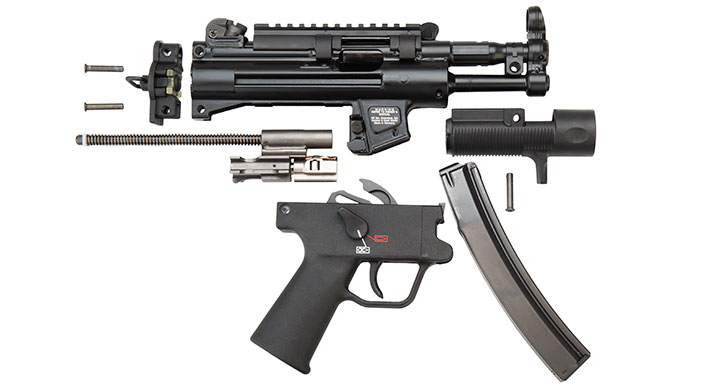
H&K’s first big firearm contract came by way of helping to arm a young German army with the G3 Infantry Rifle in 1959. The G3 shares the spotlight with the FAL and M16 families as the most prolific western longarms of the 20th century. It also spawned a slew of firearms using the same MG42-inspired, delayed roller-locking operating system. The 9 mm MP5 was one of the early spinoffs, making its appearance in the mid-’60s and quickly becoming one of the most recognizable and highly regarded submachine guns in the world. Despite the introduction of the more modernized H&K UMP family in the ’90s, MP5 variants are still being manufactured and used by police and military forces around the world today. Civilian-legal semi-auto versions are less-widely distributed, but are highly sought for their high quality, unfailing reliability and collectability within our own shores.
The new SP5K is a civilian-legal, pistol version of the MP5K coveted for clandestine roles due to its diminutive footprint. The resemblance is faithful with a couple of changes specific to the commercial market. The most obvious is a polymer handguard that incorporates a short muzzle shroud and molded-in handstop. Both features serve to keep the shooter’s support hand clear of the muzzle. No rail-mounting surfaces are present on the handguard, but the aftermarket provides many good accessory-bearing options. Since any handguard designed to fit an MP5K will fit the SP5K, it’s a simple matter of unpinning one fore-end and swapping to another. Given the price of this pistol, it would be nice to see H&K give shooters a rail option right out of the box. The gun’s opposite end features a standard MP5K end cap and sling swivel, push-pinned to the receiver at top and through both receiver and the polymer trigger group at the bottom. Shooters willing to suffer through the NFA registration and taxation process can attach an MP5K-PDW side-folding stock to the SP5K in place of the pistol’s end cap. This process converts it into a legal Short Barrel Rifle, but should only be done after receiving BATFE approval.

The SP5K ditches the MP5’s familiar paddle-style magazine release in favor of right-side-only push-button release. While a paddle is useful for dropping mags ambidextrously, most lefties are so used to right-side mag releases that rapid magazine changes from this position are second nature. Magazines go straight in and out so reloads are a cinch with the SP5K, so long as you do not load them over capacity. The 30-rounders will actually accept 31 cartridges but inserting a maxed-out magazine with the bolt forward is nearly impossible because the ammunition, follower and spring have no room to compress when pushed in against the bottom of the closed bolt. Like all H&K roller-locked operating systems I have encountered, the closed-bolt SP5K does not lock open on empty magazines. So, if you shoot your way into a sudden click after losing count of your rounds, recharging the SP5K requires you to hand-cycle the bolt after inserting a loaded magazine.
Moving topside, we find the familiar H&K rotating drum rear sight, though with four squared notches of varying widths instead of the round apertures found on MP5s and larger rifles. The front-sight blade is also the standard H&K style, fully protected by the company’s familiar sight holder. The pistol’s matte-black finish appears to be the product of the same electrically charged paint-over-phosphate technique H&K uses on the rest of the MP5 family. I have removed this finish in the past in order to modify H&K parts and it is among the toughest I have encountered on any firearm.
H&K’s forward/left-side, non-reciprocating cocking handles are probably the least-ergonomic feature of its traditional-style firearms. This location requires right-handed shooters using full-length rifles to apply rearward force with a fully extended support arm while the firing arm bears all gun and ammo weight. Lefties either rotate the firearm clockwise, then grab the cocking handle with the right/support hand or keep the firearm upright and use the left/firing hand to run the bolt. Neither technique is fluid, but fortunately the SP5K’s short length makes accessing the handle easy with either hand.
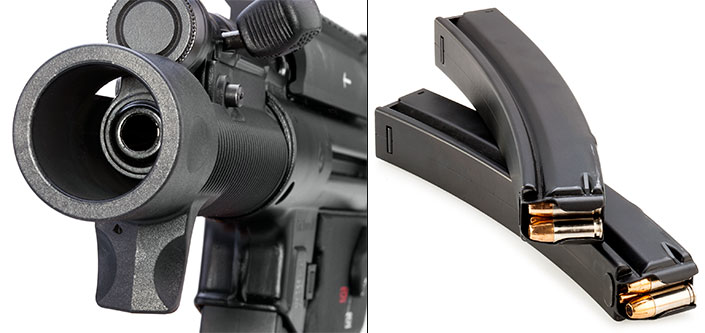
The pistol’s muzzle lacks any suppressor-mounting ability, which is surprising when you consider the tremendous popularity of suppressors in the US. The stubby 4.5-inch barrel does not protrude far enough in front of the front sight holder to be threaded nor is the familiar MP5-style, three-prong bayonet mount present. Mounting optics to H&K’s stamped, rounded receivers used to require tall, heavy and expensive claw mounts. Those steel boat anchors work well, but they would nearly eclipse the little K’s receiver. Fortunately, the SP5K comes instead with a low profile rail mount that easily clips into place over the four bosses built into the receiver. Two, 3 mm setscrews on top of the rail tension it solidly into position. Removal is achieved quickly by pressing the two spring-loaded releases on one side of the mount. The top is grooved through the long axis of the rails to allow use of the iron sights if no optic is mounted. However, the rail itself is too high to allow any sort of proper optical co-witness setup.
The SP5K came to me spotless and well lubed, in seemingly unfired condition. After a perfunctory cleaning I packed the pistol, magazines, sight adjustment tools and three brands of 9 mm ammunition off to the range. I elected to stick with the iron sights for testing to keep with the trimmed down spirit of the K. I used the narrowest rear aperture for grouping and the widest for my rapid-shooting drills. Formal shooting to check accuracy and velocity was done using a sandbag rest, which was helpful given the front-heavy nature of pistols with long, forward-positioned magazines.
Static grouping is never very exciting but the SP5K delivered a nice surprise in the way of a very consistent and clean trigger pull. I could not detect the slightest variation from one long, slow break to another and my trigger-weight scale verified the feeling. No matter how hard I try when measuring triggers, each pull will normally vary by ounces. After getting five straight, 6 pound, 10 ounce breaks with the test pistol’s trigger, I kept at it and got another 10 in a row at the exact same weight. I have never seen that level of consistency in a trigger on any firearm. While not light in the match-grade sense, such mechanical uniformity lends itself to good shooting without being unsafe in a firearm designed for something other than paper targets. The little H&K printed respectable groups, keeping all but one 25-yard group inside of 3 inches. I suspect that narrowing the .068-inch-wide-front sight would yield even tighter groups, but it was made to see quickly against body-size targets, not to drive tacks.

I experienced one malfunction early in testing, on shot number eight to be exact. While grouping the FMJ ammo, I experienced a stovepipe, with the spent brass not quite clearing the ejection port before the bolt started back into battery. However, I had the pistol choked so far forward on the rest that the ejection port was partially covered by the sandbag’s “ears”. Since the problem disappeared once I moved the SP5K rearward on the rest, I believe the blame for this malfunction falls on my technique rather than the pistol or ammunition.
Once grouping was finished, I got down to business and worked through a series of close- and mid-range drills from a standing position. Even lacking any buttstock or brace, the SP5K transmits very little recoil to the shooter due to its weight and the roller-locked bolt system. The bungee and nylon, single-point sling that accompanied the SP5K is comfortable and convenient, but provided no help as a shooting support. The normal way to fire a slung, non-stocked MP5K is to fully extend the sling to the point where it is tight, applying forward pressure with both hands to help steady the gun for aiming. Despite fully tightening the SP5K’s sling, the middle bungee section stretched too much to keep the sling rigid. Tying a knot in the bungee section helps a bit if you are stuck with this setup. Even so, I had no trouble ringing a Spectre Targets’ Mini C-Zone steel silhouette at 50 yards as rapidly as I could realign the sights after each shot.
Shooting the SP5K was every bit as fun as shooting any MP5 variant, but they share a common downside, too—loading magazines. Double-column SMG magazines are all notoriously tedious to load once you get past the halfway point, and the SP5K’s are no exception. The upside is that they are uber-durable. In fact, I think steel H&K mags in any caliber are about the toughest out there, rivaled in strength only by steel AK mags, but infinitely better in both quality and design. Besides the probable shooter-induced stovepipe mentioned earlier, no malfunctions were encountered over a total of 150 rounds fired during two range sessions. My only other functional beef with the SP5K is also shared with other H&K products using Navy-style trigger groups: The ambi-selector levers are too stiff and short (on either side) to provide sufficient leverage for rapid disengagement and engagement by the firing thumb. As a lefty, I am in the habit of actuating non-ambi selectors by using my firing thumb on the left side of the gun. I have found the same technique to be faster with H&K’s short ambi levers, too—regardless of whether I fire strong- or weak-handed.
According to Heckler & Koch, more than 100 MP5 variants exist among armies, police forces, security groups and civilian shooting communities around the world today. The SP5K may seem like just another number added to the list but unlike some of the older, NFA-compliant MP5 variants, the SP5K actually has some practicality. It would work well in any confined-space role where the need for higher capacity, accuracy and optics mounting negate normal handgun use. Whether in a day-pack, discreet-carry case or slung under a jacket MP5K style, the SP5K gives shooters who can afford to be hard-core H&K aficionados a compact way to scratch a Teutonic itch.
